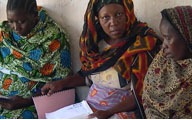
Alleviating Poverty & Countering Environmentally Unsustainable Practices
For rural coastal communities in Tanzania, the littoral and marine environment found along Tanzania’s roughly 1,200 km of coastline presents opportunities as well as challenges. Fishing, aquaculture, salt making and harvesting coastal forests and mangroves all offer potential sources of income, but unsustainable practices over the years have depleted resources and increased poverty of the roughly 9 million people who live in the 5 coastal regions. Although there have been a variety of conservation efforts during the last decade, success has been impeded by the inherent poverty and a growing population that have led to destruction of the coastal habitats and a proliferation of resource-mining activities.
Between January 2003 and December 2005, ACDI/VOCA implemented the SEEGAAD project to counter environmentally unsustainable practices and alleviate poverty within rural coastal communities in Tanzania. The overall goal was to promote activities that drive sustainable economic growth, increase cash incomes and stimulate asset accumulation among households through the following objectives:
- increase the productivity and profitability of existing and new community business activities in an environmentally sustainable manner
- expand stakeholder knowledge of, access to and control of key livelihood production and market systems
- improve the economic well-being, business activities and entrepreneurial spirit
- build the capacity of local associations, CBOs and rural residents to form and manage democratic and economically strong associations
Over a period of three years, activities were carried out in four focus areas: business skills training, extension support for production of select products, association building and improving the enabling environment. Interventions were centered in three coastal districts of Muheza, Pangani and Tanga municipality in the north, although a few other activities were carried out in south coastal Regions of Lindi and Mtwara. The Tanga Region was the primary focus area for the project.
In the early days of implementation, the project focused on promoting seaweed farming, an environmentally benign economic activity that holds enormous potential to greatly increase incomes for the greatest number of smallholders. Two types of seaweed are commercially grown in Tanzania namely Kappaphycus alvarezii (commonly calledcottonii) and Spinosum alvarezii (commonly referred to as spinosum). Although more difficult to grow, cottonii fetches almost three times the per unit price obtained forspinosum in the local market, and hence a key strategy of the SEEGAAD project was to promote the expansion of cottonii production. In addition, the SEEGAAD project collaborated with seaweed exporters to improve the delivery of extension services and to address production constraints such as seaweed die-off. Project staff as well as consultant volunteers from the Philippines and Solomon Islands carried out assessments of specific production constraints and made recommendations. For example, it was identified that seaweed die-off was more prevalent in shallow growing areas and in areas where salinity fluctuated greatly. As a result, the SEEGAAD project promoted the Indonesian deepwater seaweed farming system as a way to curb die-off. Producers were also advised on how to increase productivity through better farm management and adoption of simple efficiency measures, such as use of association-owned canoes to transport seaweed to shore.
The SEEGAAD project was a key player in the formation of Tanzania’s Seaweed Development Strategic Plan (SDPSP). ACDI/VOCA worked in tandem with the government of Tanzania, industry actors, academics and other donor-funded projects to research and write the SDSP, which provides a framework for the expansion of seaweed production in Tanzania. In July 2005 the SDSP was officially adopted as the blueprint for developing the seaweed industry in Tanzania. Implementation of the strategy is currently underway, aided in part by ACDI/VOCA’s follow-on Sustainable Environmental Management through Mariculture Activities (SEMMA) project. Since 2003 production levels of cottonii in Tanzania have increased by about 40 percent, reaching a record level of 2,400 MT in 2004. Whereas the majority of seaweed farmers earn an annual income of less than $100, the average incomes of cottonii producers rose by approximately 25 percent during the same 2003-2004 period.
At the beginning of 2005, SEEGAAD introduced a number of new activities to the Tanga region as a way of promoting economic diversity. Market assessments revealed that three activities, mud crab cage culture, lobster sheltering and prawn farming in salt ponds, were potentially highly profitable ventures for smallholder associations given the high demand both locally and also for the export market.
Although a relatively well-established activity in the Philippines and Indonesia, mud crab farming had not been implemented in the Tanga region prior to SEEGAAD. ACDI/VOCA facilitated a consultant volunteer from the Philippines to help establish trials for mud crab cage culture in three villages in Tanga. The consultant trained producers on how to identify suitable sites for crab cage placement and utilize locally available sources of feed, including oysters, snails and fish offal. At the end of 2005, trials had been successfully established in a total of 5 villages, and producers have begun to realize initial gains, with a total of 32 cages stocked with 10 crabs each valued at about $3.50. In June 2005, SEEGAAD commissioned a value chain analysis of the mud crab subsector to clearly outline market channels, profitability simulations and opportunities for industry growth. Study findings were shared with various industry stakeholders including government extension officers, producers and exporters enabling them to have a better understanding of the Tanzania’s competitive position. In addition, an inventory assessment of the national population of mud crabs and other potential mariculture products were conducted with support from SEEGAAD.
The second new activity piloted by SEEGAAD was the harvesting of South African crayfish (lobsters) through the use of cement block shelters. Placed on the large, sandy areas where lobsters forage for food at night, these shelters provide opportunities for larger catches, better growth of lobsters, and live capture—all of which significantly enhance the value of the catch. Consequently, the project engaged a group of 20 fishermen from Kigombe village in Muheza district in the first-ever trial of this kind in Tanzania. In early 2006, the fishermen from Kigombe harvested over 20 kgs of fully grown lobsters from the shelters which they sold to a local seafood exporter earning $1,000 in proceeds.
In the third activity, SEEGAAD supported field research on the farming of tiger prawns in salt ponds during the off-season for salt production. Results revealed that, with minor adaptations, tiger prawns could be grown in existing salt farms using natural feed in the water, providing significant additional income to producers. A stumbling block to the successful establishment of this activity was the constant shortage of post-larval prawns. However, a privately owned hatchery has since been established on Mafia Island, and it is expected that the facility will start supplying the required juvenile prawns in the near future.
A key achievement of the SEEGAAD project over the three years was the successful establishment of a strong entrepreneurial orientation among the project beneficiaries. The project carried out extensive business skills training enabling the participants to gain essential business analysis and management skills that were otherwise rare among smallholders. In the early days of the project, it became apparent that most smallholders, having been brought up in the socialist era, had over the years become accustomed to selling their labor and hence had little in the way of business knowledge or experience. The SEEGAAD project promoted a business skills training module that addressed topics ranging from cost-benefit analysis to product marketing. In addition, SEEGAAD also assisted smallholders in establishing business-oriented associations which could serve as an effective vehicle for driving rural agribusiness growth. At the end of the project, producers in five villages had come together in informal groups and received training on association building, leadership and group marketing. SEEGAAD also initiated the registration process for the informal groups, which have since been registered and are now operating as successful business associations.
Over 80 percent of SEEGAAD beneficiaries were women. In a population where over 75 percent of the unemployed are women, SEEGAAD played a key role in empowering women and enabling them to have a say in their communities especially by encouraging the inclusion of women leaders within producer associations. The project made important inroads in assisting smallholders to become stewards of their environment by helping them increase their incomes and protect the resource base that supports their investments.





